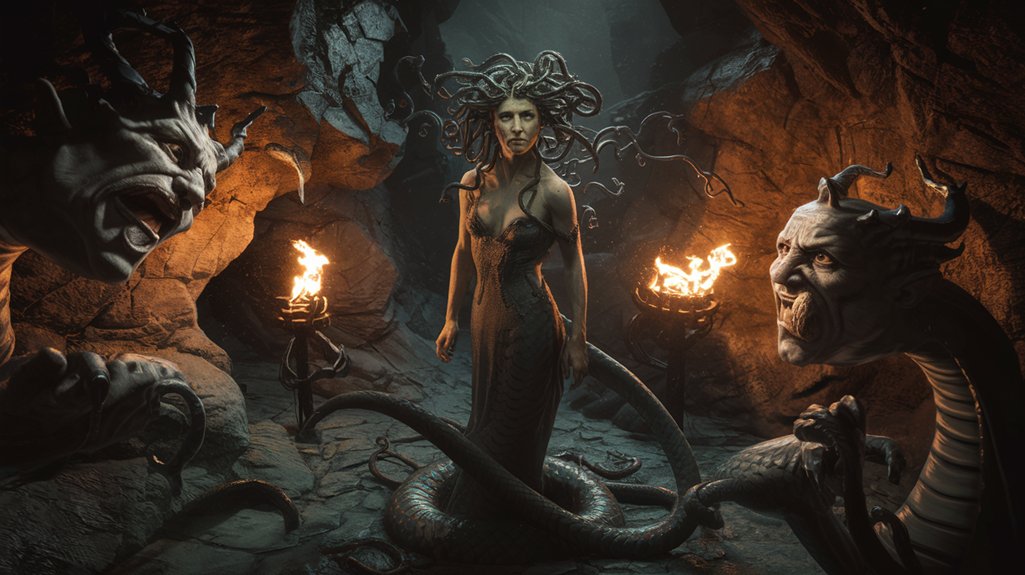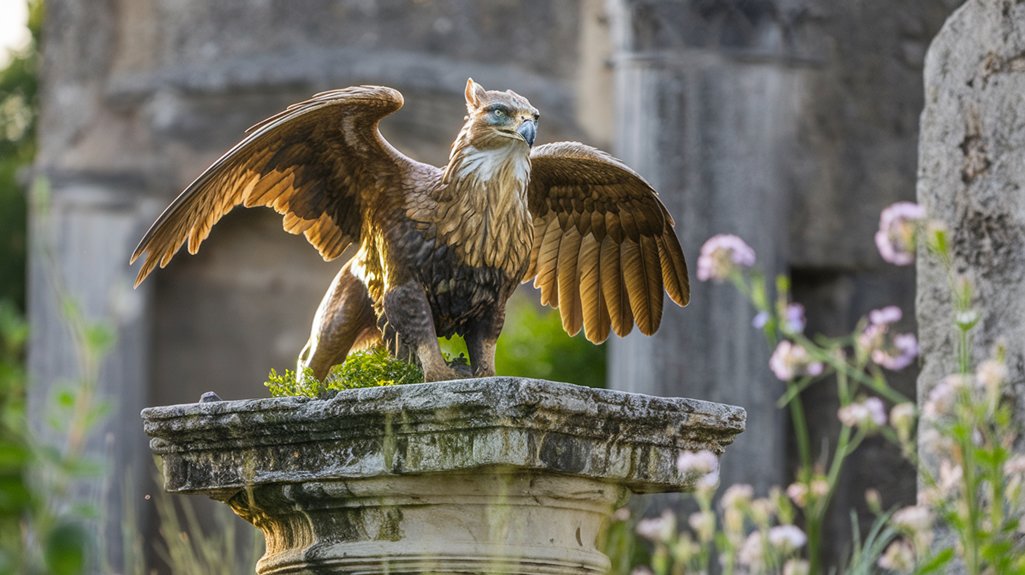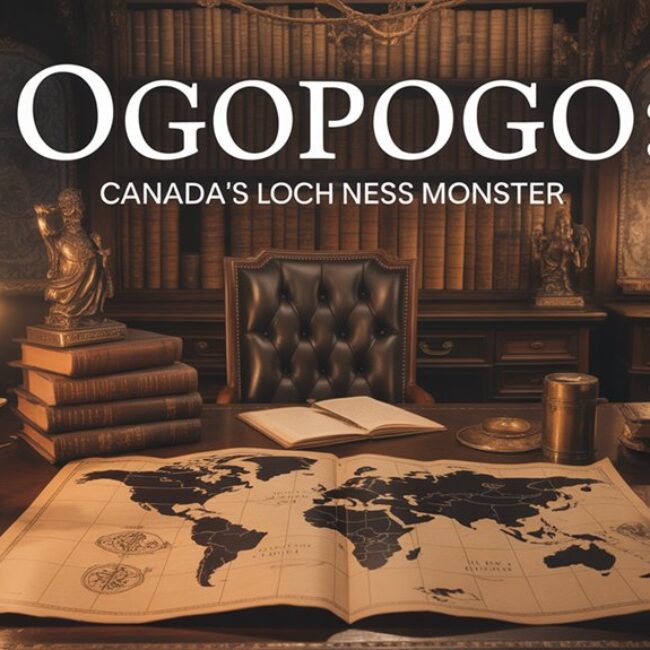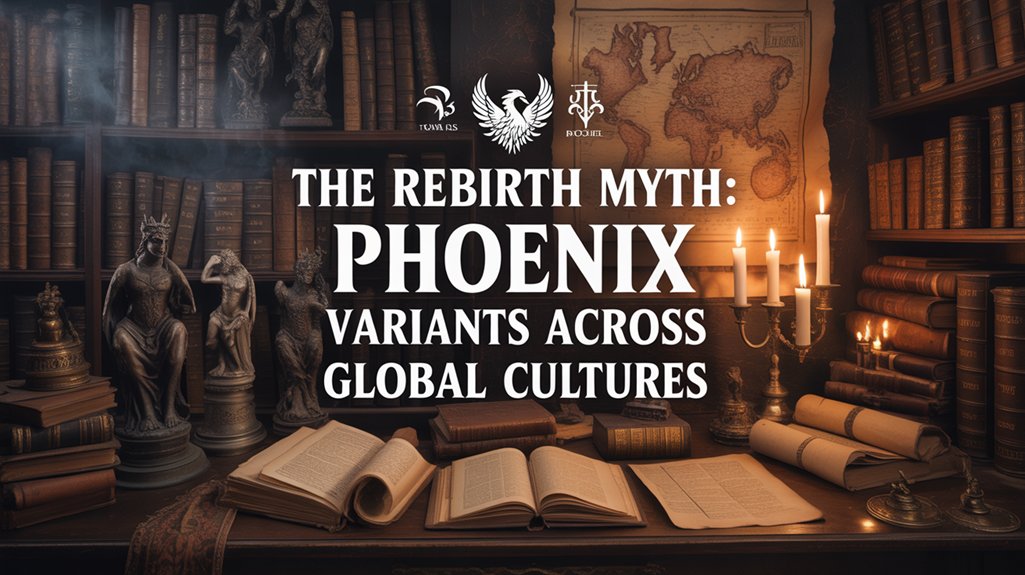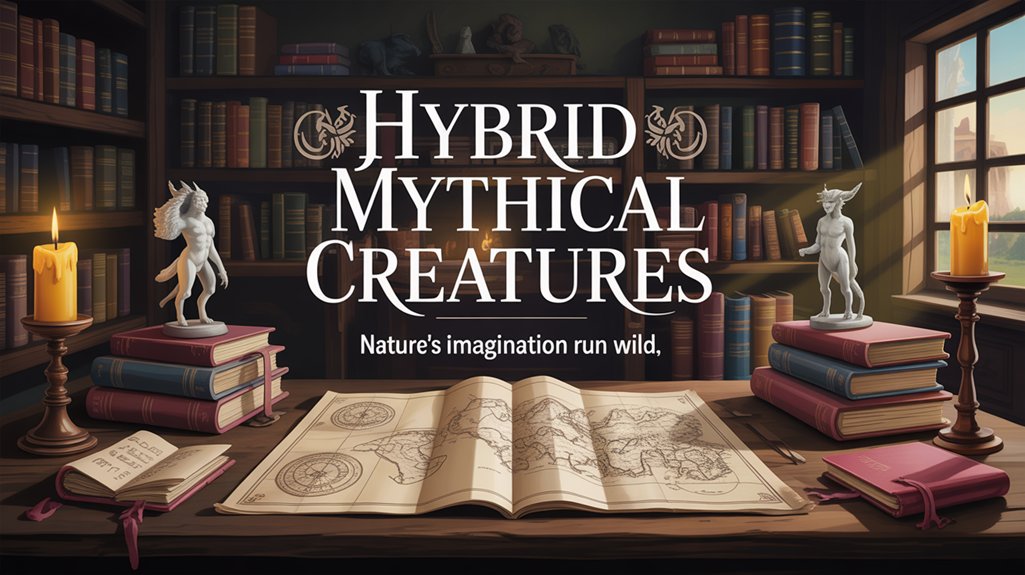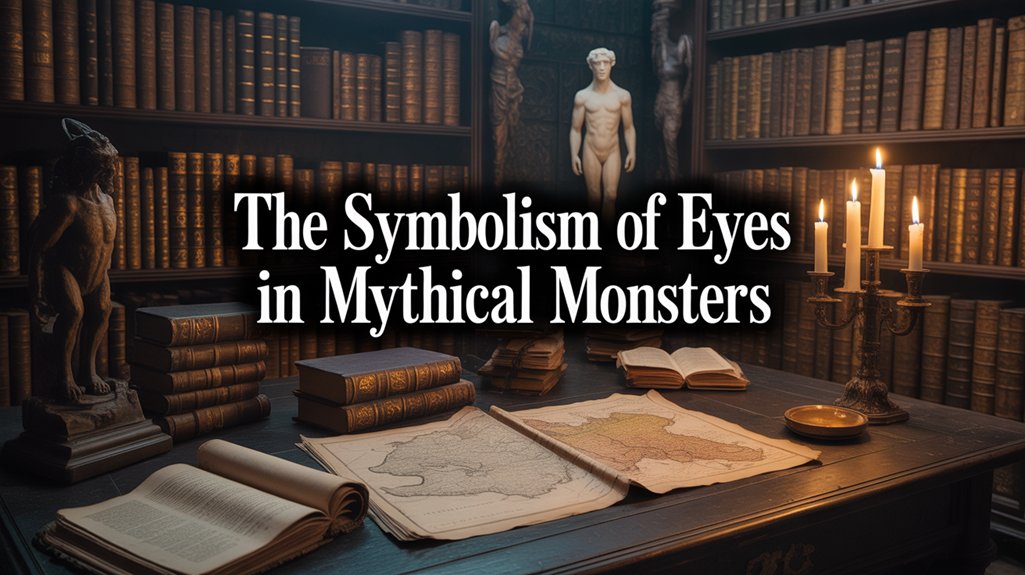
You’ll encounter psychopomps across every civilization that has contemplated mortality—intermediary beings who convert death’s chaotic dissolution into sacred passage. From Anubis’s jackal-headed vigil over Egyptian mummification (circa 2400 BCE) to Charon demanding his obol for Stygian crossing, from Valkyries selecting einherjar for Valhalla to Baron Samedi guarding Vodou cemetery gates, these liminal guides bridge the chasm between worlds. Each culture manifests its own death-shepherd: Hermes with his caduceus, Xolotl through Mictlan’s nine layers, Yama weighing karmic debts, the bean sídhe wailing prophetic warnings—all serving as necessary companions through threshold moments where earthly existence yields to what lies beyond.
Table of Contents
ToggleKey Takeaways
- Psychopomps guide souls from life to death, protecting them from malevolent forces while providing comfort during spiritual transitions.
- Anubis conducts mummification rituals and the “Opening of the Mouth” ceremony to prepare Egyptian souls for their underworld journey.
- Charon ferries souls across the River Styx for payment, while unpaid souls wander riverbanks for a century trapped.
- Valkyries selectively escort valorous warriors to Valhalla, while Hermes efficiently guides all souls using his caduceus staff between realms.
- Cultural representations vary: Yama weighs karmic debts, Xolotl guides through Mictlan’s layers, and Baron Samedi guards cemetery thresholds.
Anubis: Egypt’s Jackal-Headed Guardian of the Dead
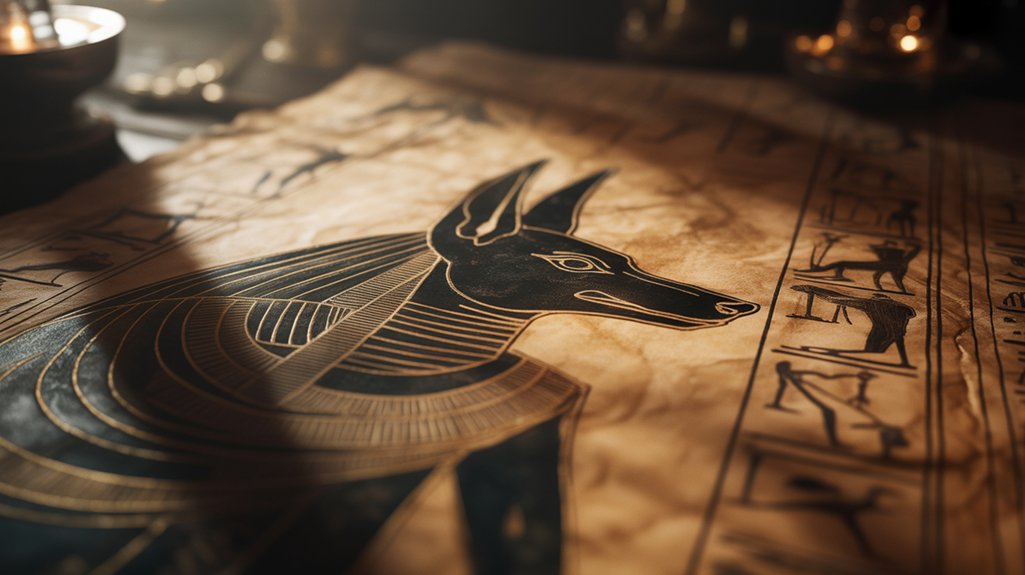
When the ancient Egyptians confronted mortality’s vast mystery, they conceived Anubis—a chimeric deity whose jackal head crowned a humanoid form, standing sentinel at the threshold between life and death.
🎯 Recommended Products
Handpicked items related to this article:
As an Amazon Associate, we earn from qualifying purchases.
You’ll find his earliest mentions in the Pyramid Texts (circa 2400 BCE), where he presided over mummification’s sacred art. The Anubis symbolism runs deep: jackals haunted desert necropolises, scavenging corpses, so Egypt changed this threat into protection. Ingenious.
Anubis rituals governed the “Opening of the Mouth” ceremony, restoring the deceased’s senses for their underworld journey. Priests donned jackal masks, becoming the god incarnate, weighing hearts against Ma’at’s ostrich feather.
You’d witness them applying natron salts, wrapping linen strips, reciting incantations that bound body to soul. This wasn’t mere superstition—it was Egypt’s answer to oblivion’s terror.
Anubis offered you passage through death’s eldritch corridors, altering corruption into preservation, fear into reverence, ending into eternal beginning.
Charon: The Ferryman of the River Styx
Where Egypt converted scavengers into psychopomps through ritualized mummification, Greek cosmology distilled death’s passage into a single, inexorable transaction.
You’ll find Charon at the threshold—gnarled, ancient, demanding payment. His obol. Your fare across the Styx.
Chthonic mythology positioned this ferryman as necessity incarnate, neither cruel nor compassionate. He simply *was*, operating where mortal law dissolved into primordial certainty.
Soul transportation became commerce, death a river crossing you couldn’t negotiate. The ancient Greeks understood this: freedom ends where the Styx begins, unless you’ve prepared. Coin beneath tongue. Respect for boundaries that predate Olympian decree.
Charon’s eldritch presence permeates fifth-century BCE funeral rites, archaeological evidence confirming obols placed in corpses’ mouths.
Funeral archaeology reveals Charon’s grip on the ancient imagination—bronze obols lodged between teeth, insurance for the final crossing.
This wasn’t superstition—it was cosmic insurance. Without payment, souls wandered riverbanks for a century, trapped between worlds. The ferryman granted passage to all who paid, democratic in his ancient office.
Liberation required acknowledging limits. Even death had protocols you couldn’t escape. Ancient Greek and Roman art preserved his image across over 1200 pictures, depicting the hooded figure who remained constant while empires rose and fell.
Valkyries: Norse Warriors Who Choose the Slain

You’ve journeyed from Greek waters to the windswept halls of Norse cosmology, where Odin’s warrior maidens—the Valkyries, Old Norse *valkyrjur* meaning “choosers of the slain—descend upon blood-soaked battlefields with eldritch purpose.
These divine psychopomps don’t merely guide all dead to their afterlife; they exercise deliberate, selective judgment, claiming only the most valorous *einherjar* (heroic warriors) for Valhalla’s mead-benches, where these chosen slain will feast and train until Ragnarök’s final battle.
Their role transcends simple escort duty—they embody fate itself, swan-maidens whose presence alters mortal combat into sacred theater, each fallen warrior a potential recruit for the gods’ ultimate war.
The Valkyries served the Viking worldview that celebrated great deeds as the path to immortal glory, transforming battlefield deaths into doorways to the divine halls where honor outlived mortal flesh.
Selecting Warriors for Valhalla
Though death claimed countless warriors across the battlefields of Midgard, only the most valorous would find themselves spirited away to Odin’s hall—and this selection fell to the Valkyries, those formidable psychopomps who traversed the boundary between life and death with deliberate purpose.
You’ll discover that warrior selection wasn’t arbitrary; Valhalla criteria demanded specific qualities. Courage in combat. Ferocity without hesitation. Honor maintained even as blood soaked the earth beneath dying limbs.
The Valkyries observed each clash with eldritch precision, noting which souls burned brightest with battle-fury, which warriors embraced their fate without cowering. They sought those who’d fight again during Ragnarök, that apocalyptic confrontation requiring Einherjar of exceptional mettle.
Only freedom-loving fighters who’d demonstrated unwavering resolve earned their psychopomp’s touch, ascending beyond mortal constraints into Odin’s eternal war-host.
Divine Maidens in Battle
While modern interpretations often soften these figures into romantic fantasy, the Valkyries of authentic Norse cosmology embodied something far more primal—battlefield spirits who straddled the liminal threshold between divine intervention and mortal annihilation.
You’ll find these divine warriors described in 13th-century Eddic poetry as Óðinn’s chosen daughters, their eldritch presence manifesting amid carnage’s crimson mist. They didn’t passively observe—they actively determined fate itself, selecting which warriors would transcend death’s embrace to feast eternally in Valhalla’s golden halls.
Their names reveal function over sentimentality: Gunnr (“War”), Skuld (“Debt”), Göndul (“Wand-Wielder”). These weren’t benevolent angels but sovereign arbiters of mortality, their sovereignty absolute, their judgment final.
You can’t domesticate such forces without losing their essential truth—the raw power of feminine divinity presiding over masculine destruction.
The Grim Reaper: Europe’s Hooded Figure With a Scythe
Across medieval Europe, beginning in the fourteenth century when the Black Death claimed nearly half the continent’s population, a singular figure emerged from humanity’s collective terror: the Grim Reaper, that skeletal psychopomp draped in tattered robes, wielding a farmer’s scythe converted into an instrument of cosmic harvest.
Death’s personification crystallized when plague decimated medieval Europe—a skeletal harvester wielding peasant tools transformed into instruments of cosmic reckoning.
You’ll find this entity’s symbolic representation crystallized during humanity’s darkest plague years, when death’s indiscriminate sweep through villages, castles, and monasteries demanded personification.
The hooded specter surpasses mere folklore. It embodies humanity’s attempt to comprehend mortality’s eldritch nature through familiar agricultural metaphor—the reaper gathering souls like wheat.
Cultural interpretations vary: Germanic traditions emphasize the figure’s inexorable judgment, while Mediterranean accounts stress its psychopompic duty as guide rather than executioner.
The scythe itself carries dual meaning: instrument of sustenance altered into harbinger of change. This chimeric fusion of peasant tool and cosmic authority grants you permission to confront death’s inevitability without ecclesiastical intermediaries.
Pure. Direct. Unadorned truth.
Hermes Psychopompos: Greece’s Divine Messenger and Soul Guide
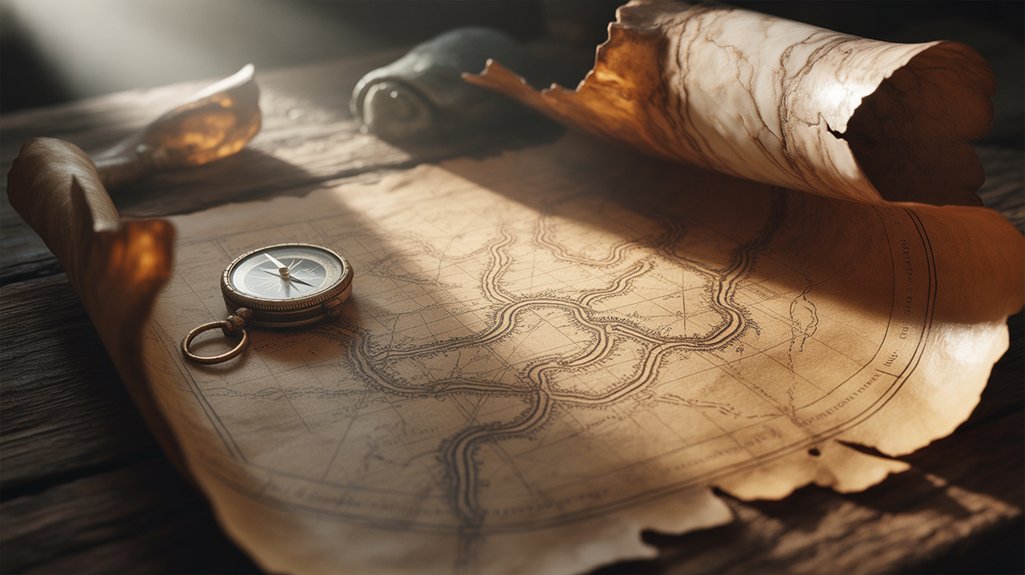
Long before medieval Europe’s skeletal harvester claimed dominion over death’s imagery, ancient Greece conceived a psychopomp of altogether different character: Hermes Psychopompos, the swift-footed messenger god whose dominion extended from Olympus’s sunlit heights to Hades’s subterranean chambers.
Within Hermes mythology, this deity bridged domains through movement itself, his caduceus staff parting the eldritch veils between life and death with practiced ease.
You’ll find no grim harvester here. Instead, Hermes guided souls with the same efficiency he delivered divine messages among immortals—neither cruel nor gentle, simply dutiful. His winged sandals carried the newly deceased across the Styx’s dark waters, his presence altering death’s passage into mere passage rather than terminal doom.
This liminal god embodied freedom through motion, refusing static categorization. Neither living nor dead, neither wholly Olympian nor chthonic, Hermes navigated boundaries others feared to cross.
Ancient Greeks recognized that death’s threshold required not a reaper’s violence but a guide’s knowledge—someone who’d walked that shadowed path countless times before.
Azrael: The Angel of Death in Islamic Tradition
Where Greece’s Hermes traversed death’s boundary with athletic efficiency, Islamic eschatology presents Azrael (عزرائيل, ‘Azrā’īl)—the Malak al-Maut whose very name means “Whom God Helps”—as death’s appointed administrator across creation’s unfathomable scope.
You’ll find Azrael’s role encompasses extracting souls with exacting precision, his form described in hadith literature as possessing seventy thousand feet and four thousand wings, each bearing countless eyes and tongues documenting Islamic mortality’s intricate ledger.
Unlike chimeric death-spirits bound to single domains, this celestial being operates across all dimensions simultaneously, his gaze penetrating the veil between corporeal and ethereal existence.
Azrael’s omnipresence transcends mortal geography—neither bound by realm nor restricted by dimension, his surveillance absolute across creation’s infinite territories.
The righteous experience his touch as gentle extraction, souls departing like water from vessels. The wicked? Their removal resembles thorns dragged through wool—painful, resistant, eldritch in its terrible necessity.
You’re confronting here not mythology’s capricious reaper but divine bureaucracy incarnate, administering change with neither malice nor mercy, merely cosmic function. Pure inevitability.
Xolotl: Aztec God Who Guides Souls Through Mictlan

While Azrael administers death with administrative precision, Mesoamerica’s Xolotl (pronounced SHO-lot-ul) embodies change’s darker twin—the divine psychopomp who didn’t merely escort souls but traveled alongside them through Mictlan’s nine-layered underworld as both guide and fellow sufferer.
Xolotl’s symbolism manifests through his chimeric form: dog-headed deity with skeletal features, twisted limbs, backward-facing feet. The Aztecs revered him as Quetzalcoatl’s twin brother, the shadow-aspect who descended into Mictlan to retrieve humanity’s bones for the Fifth Sun’s creation. His canine nature connects to the Xoloitzcuintli dogs sacrificed to accompany deceased masters, physical vessels embodying their divine patron’s guidance.
Mictlan’s significance extends beyond mere destination—it represented a four-year journey through obsidian-blade mountains, frozen deserts, devouring jaguars. Nine treacherous levels.
Xolotl understood this suffering intimately, having once fled his own sacrificial fate before accepting cosmic responsibility. You’ll find no detached administrator here. Only companionship through dissolution.
Yama: Hindu and Buddhist Lord of Death and Dharma
Thousands of years before judicial systems formalized codes of conduct, the Vedic tradition conceived Yama—history’s first moral accountant of souls, who weighs karmic debts with mathematical precision yet possesses intimate understanding of human frailty.
You’ll encounter him astride his buffalo mount, bearing his danda (staff of justice) and pasha (noose to capture departing souls), his verdant skin reflecting death’s altering power.
Yama’s symbolism manifests through five essential attributes:
- His twin crows survey mortal domains, witnessing every transgression
- The mirror of karma reflects unvarnished truth you can’t escape
- His throne faces south—direction of ancestral spirits and dissolution
- Chitragupta records your deeds in imperishable cosmic ledgers
- His sister Yami embodies life’s continuity against death’s finality
Yama’s influence permeates both Hindu and Buddhist cosmologies, where he’s changed from Vedic deity to dharmaraja—righteous king who judges without mercy yet comprehends suffering’s depths.
You’re accountable, liberated through knowledge that justice transcends mortal corruption.
Baron Samedi: Vodou’s Flamboyant Master of the Cemetery

You encounter Baron Samedi at the liminal threshold where mortality surrenders to eternity. This chimeric loa manifesting in Haitian Vodou as both psychopomp and keeper of cemetery gates, his dominion stretching across the boundary between temporal existence and the spectral domain beyond.
He demands rum-soaked offerings, cigar smoke curling upward like prayers, his iconic top hat and dark glasses marking him as guardian of the crossroads where death meets rebirth—yet this eldritch figure paradoxically preserves life itself, wielding power to deny souls their final passage.
The trickster healer emerges from West African Dahomean traditions, altered through Caribbean syncretism into a being simultaneously profane and sacred, capable of curing mortal afflictions even as he orchestrates the eternal dance of the deceased.
Guardian of Life’s Crossroads
Between the domain of the living and the dominion of the dead stands Baron Samedi, the lwa of Haitian Vodou whose dominion encompasses not merely death itself but the liminal threshold where mortality evolves into eternity.
You’ll find him presiding over life’s changes, guarding spiritual pathways with eldritch authority that transcends conventional understanding.
His jurisdiction manifests through specific domains:
- Cemetery gates — none pass without his consent
- Crossroads between worlds — where corporeal existence meets chimeric afterlife
- Temporal thresholds — birth, death, initiation
- Spiritual boundaries — protecting against premature passage
- Liminal spaces — supervising transformation’s sacred moments
He doesn’t simply collect souls.
He negotiates. You’re granted passage only when destiny dictates, when life’s final crossroad presents itself with inexorable certainty.
Ritual Offerings and Symbols
When approaching Baron Samedi’s altar, you must come bearing specific offerings—not gifts of supplication, but currencies of cosmic exchange that acknowledge his peculiar tastes and reinforce the reciprocal covenant between petitioner and lwa.
Rum infused with twenty-one habanero peppers. Black coffee, bitter and unadorned. Cigars, preferably Cubanos. These ritual offerings constitute the vocabulary through which you address this eldritch guardian of cemetery gates.
His symbolic representations manifest through specific iconography: the skull-and-crossbones cane, purple and black fabrics draped across sacred spaces, top hats positioned at grave entrances.
Each element functions as chimeric shorthand, translating abstract concepts of mortality into tangible form. You’re not decorating shrines—you’re constructing portals between worlds, establishing connections that transcend mere superstition.
Recognition demands reciprocity.
Trickster Spirit and Healer
Baron Samedi’s duality operates as essential paradox within Vodou cosmology—simultaneously the crude jokester who lewdly gyrates at crossroads ceremonies and the compassionate physician who alone possesses authority to deny death its claim.
This trickster archetype manifests through deliberate transgression, his vulgar performances dismantling societal constraints you’ve accepted as immutable. Yet within these eldritch theatrics lies profound truth: liberation demands confronting mortality’s chimeric face.
His healing journeys transcend pharmaceutical remedies:
- Restores energy through herbal pharmacopoeia known exclusively to cemetery-dwelling lwa
- Grants reprieve from terminal diagnoses when proper offerings satisfy his capricious nature
- Channels transformative wisdom through possession states, speaking forbidden knowledge
- Protects against malevolent magic targeting vulnerable souls
- Bridges material and spiritual domains during critical threshold moments
You’ll find authentic power resides not in sanitized spirituality, but in Baron’s raw, unfiltered mastery over existence’s ultimate boundary.
The Banshee: Celtic Messenger Who Foretells Death
Across the windswept moors of Ireland and the mist-shrouded highlands of Scotland, few supernatural entities command the visceral dread inspired by the banshee—that spectral harbinger whose keening wail pierces the veil between life and death.
You’ll find banshee folklore woven through Celtic mythology as something far more complex than Hollywood’s shrieking phantom. She’s the bean sídhe, “woman of the fairy mounds,” bound to ancient bloodlines through covenant rather than curse. When you hear her eldritch cry—part lamentation, part warning—death approaches someone of noble Irish lineage. She doesn’t cause death; she announces it.
Her appearance varies wildly. Sometimes a wizened crone washing blood-stained shrouds at riverside crossings. Other times, a pale maiden combing silver hair with supernatural purpose.
This chimeric nature reflects her dual role: mourner and messenger, expressing both compassion and inexorable fate. You’re witnessing profound grief made manifest, ancestral connection transcending mortality itself. Freedom from death’s uncertainty comes at terrible cost—foreknowledge without recourse.
Frequently Asked Questions
How Do Different Cultures Determine Which Psychopomp Guides a Particular Soul?
You’ll find that cultural beliefs shape soul assessment through diverse criteria—your moral conduct, manner of death, social status, or sacred rituals performed.
Ancient Egyptians weighed hearts against Ma’at’s feather; Greeks considered burial rites essential for Charon’s passage.
Your spiritual purity might summon Valkyries in Norse tradition, while Aztec tlaloques claimed those who drowned.
Each tradition establishes its own eldritch logic, determining which psychopomp claims dominion over your departing essence through cosmological laws embedded deep within ancestral wisdom.
Can Psychopomps From Different Mythologies Interact With Each Other?
You’ll find no definitive texts confirming mythological interactions between psychopomps—yet the absence of evidence shouldn’t constrain your contemplation.
Cultural exchanges throughout history suggest these liminal guides might traverse boundaries we’ve artificially imposed. When Greco-Roman traditions merged with Egyptian beliefs, Hermes and Anubis theoretically occupied shared psychopompic domains.
Whether Valkyries acknowledged Xolotl, whether Charon’s ferry passed Celtic bean sídhe remains tantalizingly unrecorded.
These eldritch guardians exist beyond our categorical constraints, operating in chimeric territories where cultural borders dissolve into mystery.
What Happens to Souls if Their Designated Psychopomp Fails to Appear?
When your designated psychopomp fails its sacred duty, you’re condemned to soul wandering—drifting through liminal domains, neither living nor properly dead.
Ancient Greek texts describe *apsychoi*, those spectral unfortunates haunting crossroads and riverbanks. Egyptian papyri warn of *akhu* trapped in the Duat’s labyrinthine passages.
This afterlife uncertainty manifests across cultures: Tibetan *bardo* states, Slavic *nav* dimensions.
You’ll exist betwixt worlds, eldritch and forsaken, until another guide claims you—or entropy dissolves your essence entirely.
Do Modern Religions Still Incorporate Traditional Psychopomp Figures in Their Beliefs?
You’ll find modern beliefs quietly preserve psychopomp symbolism, though they’ve passed into subtler forms.
Christianity’s angels guide souls heavenward; Islam’s Azrael still separates spirit from flesh; Tibetan Buddhism maintains its bardo guides with unwavering devotion.
These chimeric figures haven’t vanished—they’ve evolved, adapting ancient functions to contemporary theological frameworks.
Even secular traditions retain echoes: the “light at tunnel’s end” mirrors psychopomp encounters.
Death’s threshold still requires its guides, whether you name them angels, bodhisattvas, or archetypal presences.
Why Are Animals Like Jackals and Ravens Commonly Associated With Psychopomps?
You’ll find these creatures possess an innate symbolic significance rooted in their liminal nature—scavengers dwelling between life and death, feasting upon carrion.
Ravens, with obsidian plumage, navigate sky and earth. Jackals haunt desert necropolises. Both witness mortality’s metamorphosis.
Cultural interpretations across Egyptian, Norse, and Celtic traditions recognized their eldritch communion with decay, their ability to traverse boundaries mortals fear.
They’re threshold guardians. Death’s companions. You’re observing nature’s own psychopomps, creatures who’ve always understood what we’ve forgotten.
Conclusion
You’ve crossed the threshold between scholarly inquiry and numinous truth, witnessing death’s many faces across continents and millennia. These psychopomps—jackal-headed, hooded, feathered—aren’t mere mythology. They’re humanity’s attempt to map the unmappable, to name the ineffable passage we’ll all undertake. Their persistence across cultures reveals something profound: we’ve always needed guides through that eldritch dark. Death won’t come unattended. Someone’s waiting at the crossing.


